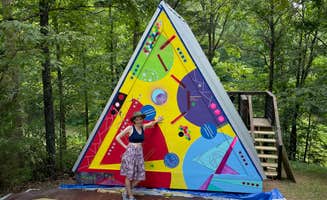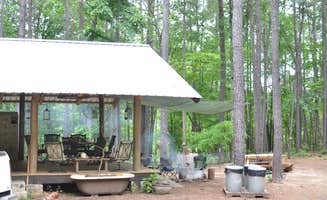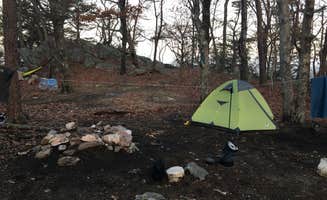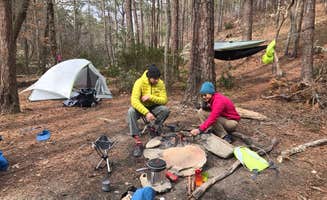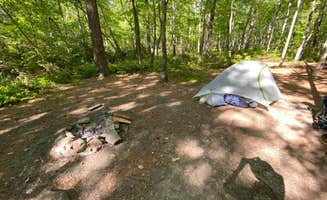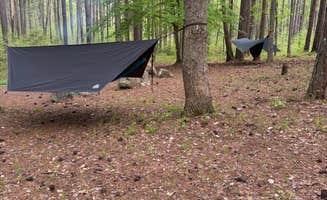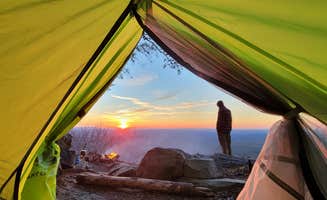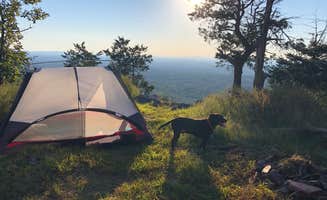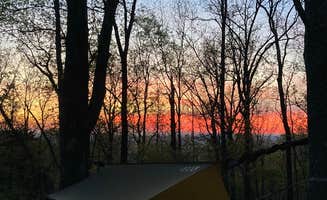Talladega National Forest spans over 392,000 acres across Alabama's central highlands, with elevations ranging from 600 to 2,400 feet. Tent campsites near Talladega, Alabama offer diverse terrain options from streamside locations to high-ridge spots. Most primitive sites throughout the forest require campers to pack essentials and follow Leave No Trace principles.
What to Do
Hiking access options: Turnipseed Campground connects directly to the Pinhoti Trail system. "Plenty of hiking trails that we hiked on was easy to make a hot meal with the fire ring was able to eat in peace saw some wildlife but not too many just a lot of woodpeckers and a few sparrows," notes Alinda S. who camped at Turnipseed Campground.
Wildlife observation: The forest hosts diverse bird species and small mammals. "We saw and heard a lot of birds and wildlife here! Explore as many trails as you can, especially the Pinhoti trail. There is a ton of diversity in this area, including lovely plants, geology, animals, and deep almost completely undisturbed wilderness," reports Lynn G. about their experience at Turnipseed.
Swimming holes: Devil's Den near Chinnabee Silent Trail Backcountry Site 9 provides excellent water recreation. "We found this spot nearby the big swimming hole 'devils den' about 1/2 a mile from the chinnabee lake parking area," writes Justin C. The site's proximity to water makes it ideal for cooling off after hiking.
What Campers Like
Budget-friendly options: Primitive camping in Talladega National Forest is remarkably affordable. "Beautiful camp sites well maintained and only $5 a night," shares Jeremy M. about Turnipseed Campground. Another camper adds, "It's a beautiful well maintained campsite with huge lots!!! It is a whopping $5 a night the best bang for your buck I've seen yet!!!"
Plane crash site: Historical wreckage along the trail to McDill Point provides a unique hiking landmark. "Be sure to check out the crashed plane on the way up which you find just off the trail about a quarter mile before the site," advises a visitor to McDill Point Backcountry. Another hiker notes, "Just past McDill, there is a side trail that takes you to debris from a 1972 plane crash site."
Seasonal considerations: Spring offers optimal conditions with wildflowers and flowing water. "I would highly suggest visiting in springtime as all the wildflowers blooming make for an incredible sight. This is also the time of year when the water levels are highest," explains a camper about Chinnabee Silent Trail. April through May typically provides comfortable temperatures and abundant natural displays.
What You Should Know
Water availability varies: Many ridge sites require carrying all water. "No water but up the mountain, at the Cheaha State Forest campground, you can refill when necessary," explains Rachel K. about Turnipseed. Sites near streams provide natural filtration sources, but these can dry up during summer months.
Limited facilities: Most tent campsites near Talladega offer primitive conditions. "We were the only ones up here for the time being but there's some good walking trails that we hiked on was easy to make a hot meal with the fire ring was able to eat in peace... There's toilets in the outhouse which is amazing," shares Alinda S. who stayed at Turnipseed.
Parking considerations: Some areas have seasonal closures affecting access. "The one major caution is to check the seasons that the site is open since it was locked up when we were there. We ended up parking at the gate and walking down the road a mile," warns a visitor to Lake Chinnabee Recreation Area. Many sites close from December through February.
Tips for Camping with Families
Short hikes with rewards: Sites near water features provide kid-friendly exploration. "The short hike to the gorgeous falls is perfect for the kids. While you can continue on for miles if you wish, we prefer to stay at the water and climb the little falls," recommends Bethany M. about Lake Chinnabee.
Site selection for groups: Look for cleared, level areas that accommodate multiple tents. "Little to no bugs, plenty of trees for shade and hammock camping. And a good fire ring built from large river rocks. This site was comfortable for our group of 4 but we felt like we were almost at max capacity," reports Justin C. about Chinnabee Silent Trail Backcountry Site 9.
Educational opportunities: Campers can learn about forest ecology and history. "The staff hosted several educational activities and were extremely helpful and informative," shares a visitor to Cheaha Falls Campground. Seasonal ranger programs often occur during summer months at established sites.
Tips from RVers
Size restrictions: Most forest sites accommodate only small recreational vehicles. "This is a tiny densely wooded primitive camp. There are outhouses but no water, some sites have old picnic tables and/or a fire pit. I would not go here in an RV," advises Lynn G. about Turnipseed Campground.
Alternative accommodation options: For those seeking more amenities, consider Bohamia. "Services are great some cabins and tents having ACs, but primitive camping allowed as well. Great showers and bathhouse with filtered drinking water option that I used daily," explains Michael C. This site offers glamping alternatives for those wanting forest proximity without roughing it.
Utility access: Understand hookup limitations before arrival. "This campsite is definitely one of the nicer options if you aren't staying up at the peak or if the peak campgrounds are full. The major thing to be aware of though is that this site has no water access any time of year (unless it is actively raining) so make sure to carry in any water you will need," warns a camper about forest sites.


